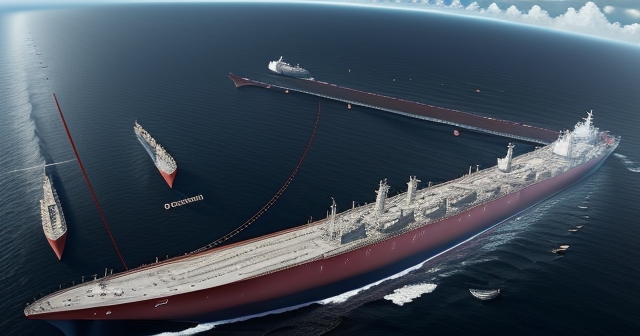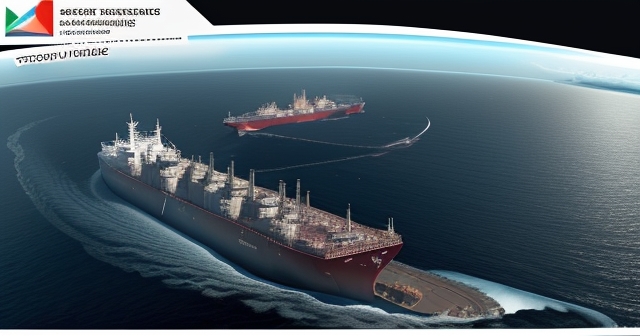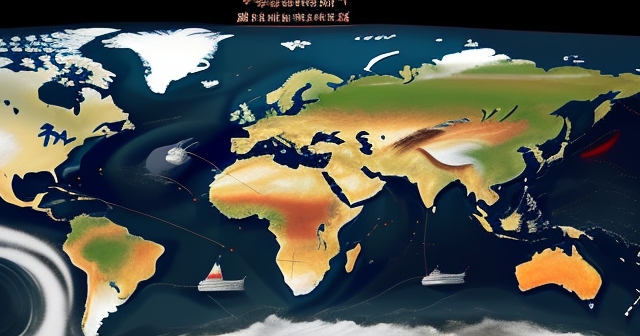
oil sanctions: How US Measures Target Iran’s Crude through China’s Teapots
“`html
Table of Contents
ToggleUS Sanctions Squeeze Iran’s Oil Trade Via China’s “Teapots” and Shadow Fleet
Global markets are inherently interconnected. Seemingly distant geopolitical events can send ripples across continents, impacting everything from energy prices to currency valuations. For those of us navigating the world of trading and investment, understanding these complex dynamics isn’t just academic; it’s a vital part of informed decision-making. Today, we turn our attention to a significant area of tension: the United States’ ongoing efforts to curb Iran’s oil exports and the intricate network, primarily centered in China, that facilitates this trade.
The United States has notably intensified its “maximum pressure” campaign against Iran. This strategy isn’t new, originating during the Trump administration, but its application continues to evolve. The core objective remains consistent: to severely curtail Iran’s ability to export crude oil, thereby cutting off a critical source of revenue the U.S. alleges is used to fund destabilizing regional activities and advance its nuclear program. To achieve this, the U.S. employs a range of economic tools, with sanctions being the most prominent.
In recent actions, the U.S. Department of the Treasury, specifically the Office of Foreign Assets Control (OFAC), alongside the State Department, has pointedly targeted entities and individuals involved in Iran’s oil trade. These actions leverage authorities granted by Executive Orders such as E.O. 13902 and E.O. 13846, as well as National Security Presidential Memorandum NSPM-2. What makes the recent moves particularly impactful is their focus not just on Iran’s state-owned oil companies, but crucially, on the international network that keeps the oil flowing. And that network’s primary hub? China.
When we analyze these sanctions, we see a clear strategy unfolding: disrupt the physical movement and financial facilitation of Iranian oil by targeting key participants in the supply chain. This includes the buyers, the transporters, the insurers, and those who handle the logistics. The goal is to make it increasingly difficult, risky, and expensive for Iran to sell its oil on the international market, forcing potential buyers and facilitators to choose between lucrative trade with Iran and access to the U.S. financial system and global dollar-denominated commerce. It’s a high-stakes economic showdown.

Let’s take a moment to appreciate the context. The “maximum pressure” campaign wasn’t conceived in a vacuum. It was a strategic shift following the U.S. withdrawal from the Joint Comprehensive Plan of Action (JCPOA), often referred to as the Iran nuclear deal. The premise was that rigorous economic sanctions would compel Iran to renegotiate a broader agreement addressing its nuclear program, ballistic missile development, and regional influence.
Initially, sanctions primarily focused on Iran’s central bank and the National Iranian Oil Company (NIOC). However, for sanctions to be effective, they must not only target the seller but also deter the buyer. If a buyer can still find ways to acquire Iranian oil, the intended pressure is significantly diluted. This led to the expansion of sanctions to target foreign entities facilitating transactions or transporting Iranian crude.
Over time, Iran, and its trading partners, developed sophisticated methods to circumvent these restrictions. This included disguising the origin of oil shipments, conducting illicit ship-to-ship (STS) transfers in remote waters, using obscured ownership structures for vessels, and facilitating payments through less conventional financial channels. This cat-and-mouse game between enforcers and evaders has defined the landscape of Iran’s oil exports under sanctions.
The U.S. response has been to adapt and expand its targeting. Moving beyond just primary buyers, OFAC has increasingly listed vessels, shipping companies, and even individuals like vessel captains who play a crucial role in masking these shipments. They’ve also turned their attention to the logistical bottlenecks – the ports and terminals willing to handle these controversial cargoes. This evolution demonstrates a deep dive into the operational realities of clandestine oil trade, seeking to choke the flow at multiple points.
The Evolution of US Sanctions Strategy Against Iran
Why the focus on China? Quite simply, China has remained the single largest destination for Iranian crude oil exports, even under the heaviest U.S. sanctions. While official Chinese customs data might report minimal or zero imports from Iran since specific dates (like July 2022), analysts using satellite tracking and other methodologies consistently show significant volumes arriving, often disguised as originating from other countries, particularly Malaysia or Oman.

Within China, a key segment of the oil market has been particularly active in purchasing discounted Iranian crude: the independent refiners. These privately or locally owned refineries, often referred to as “teapots” due to their smaller scale compared to state giants like Sinopec or PetroChina, have been opportunistic buyers. Attracted by the steep discounts Iran offers to find buyers under sanctions, these teapots have absorbed a large portion of Iran’s available export barrels.
The recent sanctions went directly after these players. OFAC designated several Chinese entities for their involvement in purchasing, receiving, or facilitating billions of dollars’ worth of Iranian crude oil. Specific names emerged from the sanctions lists: Shandong Shouguang Luqing Petrochemical Co., Ltd., Shandong Shengxing Chemical Co., Ltd., and Hebei Xinhai Chemical Group Co., Ltd. These were not just buyers; the U.S. cited their role in supporting the National Iranian Oil Company (NIOC), which itself is linked to the Islamic Revolutionary Guard Corps-Qods Force (IRGC-QF), an entity the U.S. designates as a foreign terrorist organization.
| Chinese Entity | Involvement |
|---|---|
| Shandong Shouguang Luqing Petrochemical Co., Ltd. | Involved in purchasing Iranian crude oil |
| Shandong Shengxing Chemical Co., Ltd. | Facilitating Iranian oil transactions |
| Hebei Xinhai Chemical Group Co., Ltd. | Supporting NIOC activities |
But the sanctions didn’t stop at the refiners. Recognizing that oil needs to be transported and offloaded, the U.S. also targeted key logistical nodes. Port terminal operators in Shandong Province, a major hub for teapot activity, were designated. Entities like Baogang (Dongying Donggang) Logistics and Warehousing Co., Ltd., Shandong Jingang Port Co., Ltd., and Shandong Baogang International Port Co., Ltd. were called out for facilitating the delivery of Iranian oil. This step marked an escalation, directly challenging the infrastructure enabling the trade within China.
The Immediate Operational Fallout: Disruptions in China
What happens when a Chinese independent refiner or port operator is added to the U.S. Specially Designated Nationals and Blocked Persons List (SDN List)? The consequences are far-reaching and immediate. For the sanctioned entities, it’s like hitting a brick wall in the global financial system. Any assets they hold under U.S. jurisdiction are blocked, and U.S. persons are generally prohibited from engaging in transactions with them. While the direct impact on assets might be limited for entities primarily operating within China, the secondary effects are crippling.
Consider the operational challenges. Sanctioned refiners suddenly face difficulty in receiving their crude shipments. Major state-linked port operators, like the powerful Shandong Port Group, which manage much of the coastal infrastructure, become extremely wary of handling cargoes destined for or linked to sanctioned entities. Reports emerged of vessels linked to sanctioned refiners being denied entry or discharge services at key ports, forcing them to scramble for alternatives. Where can they offload? Perhaps smaller, privately owned terminals, but these often lack the capacity or infrastructure of the larger state ports, adding significant delays and costs.
Financing becomes another major headache. Chinese state-owned banks, while operating within China, have extensive international operations and rely heavily on access to the U.S. dollar system. They become extremely reluctant to process payments or provide credit to entities on the U.S. SDN list, even for their domestic operations. This financial squeeze can disrupt everything from purchasing crude (even non-sanctioned barrels) to funding day-to-day expenses.
Furthermore, sanctioned entities face challenges in selling their refined products. While they might process the Iranian crude, selling gasoline, diesel, or other products under the name of a sanctioned company becomes difficult. They may need to resort to selling through intermediaries or under new, potentially opaque entity names, adding complexity and reducing margins. This isn’t just an inconvenience; it’s a fundamental disruption to their business model, which relied on purchasing discounted crude and operating relatively freely within the domestic market.
| Challenge | Impact |
|---|---|
| Difficulty in crude shipment reception | Operational paralysis for refiners |
| State-owned banks’ reluctance to finance | Limitations on purchasing crude |
| Challenges in selling refined products | Loss of market access |
Beyond Direct Targets: The Broader Deterrence Effect
Perhaps the most potent impact of these targeted sanctions isn’t just the operational disruption they cause for the listed entities, but the broader “chilling effect” they have on other, non-sanctioned players in the market. When prominent independent refiners and port operators are targeted, it sends a powerful signal to everyone else involved in the China-Iran oil trade: you could be next.
This fear of secondary sanctions – the risk of being cut off from the U.S. financial system and global commerce simply for dealing with sanctioned parties or facilitating sanctioned trade – is a significant deterrent. Many independent refiners, even larger ones that had previously dabbled in Iranian crude or considered it, may decide the potential risks outweigh the benefits of the price discount. They might halt Iranian crude purchases entirely or drastically reduce them to avoid drawing U.S. attention.
This shift in buyer behavior has tangible market consequences. If a large segment of your potential customer base becomes hesitant or stops buying, what must a seller do to find willing buyers? They must lower the price. Analysts tracking the market have noted that these U.S. sanctions, by reducing the pool of willing buyers in China’s teapot sector, have contributed to a widening discount on Iranian Light crude oil compared to international benchmarks like ICE Brent. The bigger the perceived risk of buying Iranian oil, the larger the discount Iran must offer to incentivize buyers.
This deterrence effect isn’t limited to refiners. It also impacts shipping companies, insurers, classification societies, and financial institutions globally. Even if they aren’t directly targeted initially, the risk of facilitating a transaction that might eventually involve a sanctioned entity makes them cautious. This makes it harder and more expensive for Iran to find ships willing to carry its oil, obtain insurance, or process payments, further squeezing its export capabilities.
Unmasking the “Shadow Fleet”: Iran’s Sanctions Evasion Arsenal
Iran’s ability to export any significant volume of oil under sanctions relies heavily on what is often referred to as its “shadow fleet.” This isn’t a formal navy or even a publicly acknowledged commercial fleet. Instead, it’s a complex, constantly evolving network of oil tankers operating under layers of secrecy designed to obscure their ownership, origin, and destination.
How does this shadow fleet operate? It employs several techniques to evade detection and sanctions. One common method is disabling or manipulating the vessel’s Automatic Identification System (AIS) transponder, which is legally required for safety and tracking. By going “dark,” these ships attempt to disappear from global tracking systems.
Another critical technique is the ship-to-ship (STS) transfer. Instead of loading directly from an Iranian port and sailing to the destination, tankers will often meet in remote waters, such as parts of the Persian Gulf or off the coast of Oman or Malaysia. The oil is transferred from a vessel that might have loaded in Iran to another tanker. This second tanker then sails to the destination, often with false documentation claiming the oil originated from a different location. This adds a layer of complexity and makes tracing the origin difficult.

The ownership structures of these vessels are often deliberately opaque, registered in obscure jurisdictions (like Panama, Sao Tome and Principe, San Marino, Marshall Islands) and managed by shell companies with no public presence. This makes it hard to identify who is ultimately responsible for the shipment. Similarly, vessel captains play a crucial role in executing these evasive maneuvers, from managing AIS signals to coordinating STS transfers.
Recognizing this, the U.S. has systematically begun targeting the shadow fleet. OFAC has designated specific vessels (listing them by name, like STAR TWINKLE 6, LAMD, SKADI, BIG MAG, IMPALAS, THANE, among others) and the companies that own or manage them (e.g., Star Twinkle Shipping Limited, Hong Kong Prime Trading Co., Ltd., Skadi Limited). In an unprecedented step, the U.S. has even sanctioned individuals, including Indian national vessel captains Ketan Agarwal and Lincoln Francisco Viegas, for their roles in operating vessels involved in transporting sanctioned Iranian oil. This targeting of personnel aims to raise the personal risk for those directly involved in operating these illicit shipments.
The Geopolitical Chessboard: Sanctions, Nuclear Talks, and China’s Balancing Act
It’s important to view these sanctions not just as isolated enforcement actions but within the broader context of U.S.-Iran relations and regional dynamics. The “maximum pressure” campaign is intrinsically linked to the stalled negotiations surrounding the potential return to the JCPOA. From the U.S. perspective, maintaining and increasing economic pressure is a tool to bring Iran back to the negotiating table and extract further concessions on its nuclear program and other activities.
However, Iran views the sanctions as economic warfare and a violation of the original nuclear deal, particularly since the U.S. withdrew first. Tehran has often responded to increased pressure by escalating its nuclear activities or engaging in regional provocations, creating a dangerous cycle of escalation.
Where does China fit into this geopolitical puzzle? China has consistently stated its opposition to unilateral sanctions not mandated by the United Nations Security Council. It defends its legitimate trade relations with Iran and criticizes the U.S. for extraterritorial application of its laws. From Beijing’s perspective, trade with Iran serves its energy needs and economic interests, and it resents U.S. attempts to dictate its foreign trade partners.
| Chinese Actions | Effect on Sanctions |
|---|---|
| State-linked entities cease purchases | Limits Iranian export capabilities |
| Independent refiners purchase instead | Continues flow of Iranian crude |
| Opposition to U.S. stance | Strains Sino-U.S. relations |
Yet, despite its official stance, China is not immune to the impact of U.S. sanctions. While some Chinese entities, particularly independent ones, have been willing to operate in the grey areas of sanctions enforcement to secure discounted oil, major state-owned enterprises (SOEs) are typically more cautious. They have significant international exposure and are more vulnerable to direct U.S. targeting or being cut off from international finance. Reports indicate that some state-linked entities, such as CNOOC, have reportedly stopped supplying crude oil to refiners known to be associated with sanctioned entities, indicating a degree of internal caution driven by sanctions risk.
China’s strategy appears to be a balancing act: officially oppose sanctions while allowing some level of covert trade, but also avoid actions that would provoke the U.S. into targeting its major SOEs. Analysts like Fernando Ferreira from Rapidan Energy Group often assess the current level of sanctions pressure and project potential next steps, suggesting that if the current targeting of teapots and the shadow fleet doesn’t sufficiently reduce Iran’s exports, the U.S. might consider the unprecedented step of sanctioning major Chinese state-owned oil companies, which would represent a significant escalation with potentially wider market repercussions.
The Legal Framework: OFAC, SDN List, and Consequences
Understanding the impact of these sanctions requires a brief look at the legal machinery behind them. When the U.S. government imposes sanctions related to Iran’s oil trade, it typically involves designations by OFAC. OFAC maintains the Specially Designated Nationals and Blocked Persons List (SDN List). Any entity or individual placed on this list has their assets that are subject to U.S. jurisdiction blocked.
Crucially, U.S. persons – which includes U.S. citizens, permanent resident aliens, entities organized under the laws of the United States or any jurisdiction within the United States (including foreign branches), and anyone in the United States – are prohibited from engaging in any transactions with entities or individuals on the SDN List. This includes facilitating transactions involving them, providing services to them, or receiving anything of value from them. This is the core mechanism that makes it difficult for sanctioned parties to operate in the international financial system.

But the reach of U.S. sanctions extends further through secondary sanctions. These authorities, like those under E.O. 13902 which targets sectors of the Iranian economy including petroleum, enable the U.S. to sanction *non-U.S. persons* who engage in certain activities with sanctioned Iranian entities or sectors. For example, a foreign bank that facilitates a significant financial transaction for NIOC, or a foreign shipping company that knowingly transports Iranian oil, could face U.S. sanctions, including being added to the SDN list themselves and losing access to the U.S. financial system.
Violations of U.S. sanctions can carry severe penalties, both civil and criminal. These can include substantial fines (often millions of dollars) and imprisonment. This legal risk is precisely what deters foreign companies and individuals from engaging in sanctioned activities, even if they are not based in the United States. The complex web of ownership structures and disguised shipments is an attempt to avoid detection and thus avoid these legal consequences, but the increasing U.S. focus on uncovering these methods makes the risk ever higher.
Market Implications for Traders: Navigating Geopolitical Risk
How do these complex geopolitical maneuvers and sanctions enforcement actions connect back to us as traders? Geopolitical risk is a fundamental factor influencing global markets, especially those tied to energy and international trade. Sanctions on a major oil producer like Iran, and the disruption they cause to supply chains, directly impact the supply side of the global oil market. Even if the exact volume of restricted oil is debated, the *risk premium* associated with potential supply disruptions or further escalations can influence prices.
When you observe news about new sanctions, successful enforcement actions, or attempts to circumvent restrictions, think about their potential impact on oil prices (like WTI or Brent crude). Reduced supply or increased difficulty in transportation adds upward pressure on prices, while successful evasion or easing tensions might remove a risk premium. Understanding these dynamics helps inform your fundamental analysis of the energy sector.
Furthermore, shifts in energy markets can ripple into currency markets. Countries that are major oil exporters (such as Canada, Norway, or Middle Eastern nations) often see their currencies influenced by oil price movements. Similarly, currencies of major energy importers could also react. Geopolitical tensions and trade disputes can also impact broader market sentiment, affecting indices and other asset classes.
For those considering exploring trading instruments affected by such global events, finding a reliable platform is crucial. If you’re considering beginning forex trading or exploring more CFD instruments, then Moneta Markets is a platform worth considering. It comes from Australia and offers over 1000 financial instruments, suitable for both novice and professional traders. Understanding the interplay between geopolitics, commodities, and currencies is key for informed trading decisions, and having access to diverse instruments on a flexible platform can be advantageous.
| Trading Considerations | Recommended Actions |
|---|---|
| Monitor geopolitical news | Stay updated on sanctions developments |
| Analyze oil price trends | Adjust trading strategies accordingly |
| Utilize risk management tools | Implement stop-loss orders and reviews |
Technical analysis remains an indispensable tool even when fundamental factors like sanctions are in play. Price charts reflect the collective market reaction to all available information, including geopolitical news. Volume, support and resistance levels, and chart patterns can help us identify trends and potential turning points that are being driven, in part, by these underlying fundamental forces. Combining a solid understanding of macro events with robust technical skills allows for a more holistic approach to the markets.
In choosing a platform to trade the markets influenced by these factors, the flexibility and technological edge matter. In selecting a trading platform, Moneta Markets‘ flexibility and technological advantages are worth noting. It supports popular platforms like MT4, MT5, and Pro Trader, combining high-speed execution with low spread settings to provide a good trading experience. Knowing your platform can handle volatility and provide the tools you need for analysis is vital when navigating markets sensitive to geopolitical shifts.
Analyst Perspectives and Future Outlook
What do market analysts and geopolitical experts think about the effectiveness and future trajectory of these sanctions? Opinions vary, but there’s general agreement that the sanctions, particularly the targeting of China’s teapot sector and the shadow fleet, have made it harder and more expensive for Iran to export oil compared to a scenario without sanctions. However, they haven’t completely halted exports.
Analysts at firms like Vortexa and Kpler, who track global oil flows using various data sources (including satellite imagery and port reports), provide crucial insights into the actual volumes of Iranian oil reaching the market, often highlighting the discrepancy between official customs data and observed flows. Their work underscores the persistence of Iran’s export efforts despite the pressure.
The key question for the future is whether the U.S. will further escalate its pressure. As mentioned earlier, one potential, albeit highly impactful, step could be targeting major Chinese state-owned oil companies. Such a move would represent a significant shift and could force Beijing to make a more explicit choice between its economic relationship with the U.S. and its trade with Iran, potentially leading to considerable market volatility.
Another area of focus is the effectiveness of targeting the shadow fleet. While sanctioning vessels and companies adds costs and complications, the network is vast and adaptable. New shell companies can be created, and different vessels can be brought into service. The success of this strategy depends on the U.S.’s ability to continuously identify and target the evolving network faster than Iran can rebuild it.
The ongoing US-Iran nuclear talks also cast a shadow over the sanctions regime. A breakthrough in negotiations could potentially lead to sanctions relief for Iran, including on its oil exports, which would dramatically alter the market landscape. Conversely, a collapse of the talks could signal further escalation of sanctions pressure. The geopolitical context is therefore crucial for assessing the likely future trajectory of Iranian oil flows.
Conclusion: Navigating a Complex Landscape
The U.S. sanctions targeting Iran’s oil exports via China’s independent refiners and the clandestine “shadow fleet” represent a significant front in the ongoing “maximum pressure” campaign. By specifically listing Chinese teapot refiners, port operators, vessels, shipping companies, and even individuals involved in facilitating the trade, the U.S. aims to directly disrupt the logistical and financial networks that keep Iranian oil flowing, primarily to China.
As we’ve seen, these measures create immediate operational hurdles for the sanctioned entities, forcing them to seek alternative ports, struggle with financing, and adapt their sales strategies. More broadly, the sanctions create a powerful deterrent effect among other market participants, contributing to widening discounts on Iranian crude as the pool of willing, unsanctioned buyers shrinks.
The constant evolution of Iran’s sanctions evasion tactics, particularly the intricate operations of the shadow fleet using STS transfers and disguised origins, means the enforcement effort is a continuous challenge. The U.S.’s strategy is to dismantle this network piece by piece, increasing the risk and cost for all involved.
Ultimately, the effectiveness of these sanctions in achieving U.S. policy goals – whether cutting Iran’s revenue sufficiently or pushing for a new nuclear agreement – remains subject to the complex interplay of enforcement, evasion, and broader geopolitical factors, including China’s delicate balancing act and the unpredictable path of U.S.-Iran relations. For those of us involved in trading and finance, understanding these dynamics is essential for navigating markets influenced by global energy flows and geopolitical risk.
Paying attention to these developments, whether through fundamental analysis of news and data from sources like OFAC, Vortexa, or Kpler, or by using technical analysis to interpret market reactions, allows you to build a more comprehensive picture of the forces shaping the markets we trade. Staying informed and adaptable is key in such volatile and complex environments.
oil sanctionsFAQ
Q:What are the main goals of the U.S. sanctions against Iran?
A:The U.S. sanctions aim to curtail Iran’s ability to export crude oil, diminishing its revenue sources used for destabilizing activities and advancing its nuclear program.
Q:How have sanctions affected Iranian oil sales to China?
A:Sanctions have targeted Chinese entities buying Iranian oil, but many still find ways to purchase crude, often at discounted rates, albeit with increased complications.
Q:What is the significance of the shadow fleet in Iran’s oil exports?
A:The shadow fleet consists of tankers that operate covertly to evade detection and sanctions, enabling Iran to continue exporting oil despite restrictions.
“`
You may also like
Calendar
| 一 | 二 | 三 | 四 | 五 | 六 | 日 |
|---|---|---|---|---|---|---|
| 1 | 2 | 3 | 4 | 5 | 6 | 7 |
| 8 | 9 | 10 | 11 | 12 | 13 | 14 |
| 15 | 16 | 17 | 18 | 19 | 20 | 21 |
| 22 | 23 | 24 | 25 | 26 | 27 | 28 |
| 29 | 30 | 31 | ||||
發佈留言
很抱歉,必須登入網站才能發佈留言。